Around this time two years ago Katrina Kaif sat languid, sated, gazing out of her boudoir, a reveur, across the floodplains of Betwa. Following her gaze through the viridian penumbra that gleamed off the landscape, we were treated briefly to an array of elevated dome-shaped pavilions, solemn sentinels along the Kanchana Ghat. The scappled-gold morning light radiated desire, her four-poster bed hugger-mugger. There was promise of more liaisons in the air. Giving wings to our hopes, she took off her chudis – bangles, an auspicious symbol in Indian marriages – and sprang stealthily like a gazelle across a courtyard with a festooned diwan marking the perilous proximity of a powerful male. Maybe it was Jahangir who was passing by, hosted by good friend and king Raja Bir Singh Deo. The pallu of her barely-there burgundy sari glided over an elaborate floral relief and ornate plinth. Katrina of course gamboled towards a mango tree sprouting juicy fruits which fell into a copper or brass lode, flailing her face with orgiastic water showers. More than a stately backdrop to a feverish pursuit, the pavilions wonderfully conveyed the zeitgeist of this period ad for a mango drink.
Today the local shopkeepers expect you to buy a bottle of the drink after they enlighten you with related tidbits like ‘The whole riverside was packed to get a glimpse of Katrina’ or ‘Baap re she was hot!’ You buy and relish the drink with a newfound intimacy. The commercial became more a talking point for upping the adult ante in the FMCG segment than for the location – Orchha. Then, when Indian films are not really known to boost tourism – we have seen Sholay many times, but how many has been to the scenic Ramanagara? – pinning hopes on an ad, even if it has Katrina, would be like expecting the Janlokpal to have teeth. And Orchha remains what it means – ‘hidden treasure.’
The historic Bundelkhand region – arid and craggy between the Indo-Gangetic plains to the north and the Vindhya Mountains in the south – was once governed from Orchha. (Bundelkhand now falls between Uttar Pradesh and Madhya Pradesh, mostly in the latter. In the recent past there have been repeated calls for a separate Bundelkhand state, a ‘Vindhya Pradesh’ which has not really caught on.) Founded in 1531 by the banks of the Betwa River, Orchha was not just the richest in the region but also rose to architectural prominence under the rule of Bir Singh Deo who built the Jahangir Palace a heritage marvel, a true example of ‘harmonised imagination and organised execution.’ Orchha lost its relevance on the political map when the capital shifted to Tikamgarh in 1738. Rarely mentioned in the same breath as Gwalior or Jaipur, Orchha is an archaeological and historical gem which continues to be cloaked in public ignorance and apathy. Though only a slight detour – 15 kilometres – from Jhansi, most tourists heading from Agra or Gwalior continue onto Khajuraho with the faintest idea of what they are missing.
Jahangir Mahal
The Ganesh Darwaja – a gigantic arched gateway with a bulbous dome and ornate embellishments on the spandrel – ushers you into Orchha town with a regal flourish. The Jahangir and Raja Mahals, set within a large quadrangle, are the biggest attractions of Orchha. To reach the fort complex, you pass through a bridge flanked by government offices on one side and eateries on the other. (The Ram Raja Restaurant here serves not-so-good pizza but quite-good milk shakes.) The Jahangir Palace, built during the 17th century by Raja Bir Singh Deo, is an amalgamation of Hindu and Mughal architectural styles. Story goes that Bir Singh and Prince Salim (before he became Emperor Jahangir) were great friends and the palace was renamed to honour Jahangir when he was passing through after his coronation.
The Raja Mahal built by the founder of the kingdom, Raja Rudra Pratap, is the oldest monument in Orchha and is in the fort premise. The series of still-intact paintings depicting the life of Lord Ram and Krishna are not to be missed here. Other attractions around the fort area are the Dau Ji Ki Kothi, the house of a trusted commander and Rai Praveen Mahal, the haveli of a famous courtesan – both in grievous states of repair by the ASI.
Lakshminarayan Temple
This temple atop a butte is yet another architectural feat of Raja Bir Singh. Built in 1622 incorporating both temple and fort styles, it looks like an impregnable fort from a distance. Episodes from the Ramayana and Bhagwad Gita come alive in the mural paintings that colour the walls.
Ram Raja Temple
Among the holiest Hindu pilgrimage destinations, the Ram Raja Temple is the only temple in the country where Lord Rama is worshipped as a raja or king. In the sanctum sanctorum, Lord/King Ram holds a sword in his right hand and a shield in the other. His wife Sita and brother Lakshman are on either side; the others completing the divine durbar include Goddess Durga, King Sugreev and Narsingh. The first wedding invite of an Orchha resident is always addressed to this ‘Raja’.
Chaturbhuj Temple
The Chaturbhuj Temple is actually an empty temple, a construction that couldn’t be completed due to a Mughal invasion. A massive structure soaring from a steep platform, with bridge-like sandstone lintels crisscrossing the apadana that is the interior, you’d expect Lara Croft to swing by. Probably the lack of any godly supervision or the plethora of dark, secluded corners, the temple is a favourite with dating couples. Several sweet and curio shops surround the temple compound which it shares with the bustling Ram Raja Temple nearby.
Phool Bagh
Even though a fine specimen of architectural ingenuity with a large pavilion in the centre adorned with ornate arches et al, this is like a study tour in scatology. A multitude of vagabonds, Abraham-men and destitute women have made it a layover with no intent of moving out. This was originally a garden with a vast subterranean residence where the Bundela kings shifted into during summer. There were intricate water systems which would simulate rainfalls in these underground chambers. Watch out for pickpockets and generally edgy itinerants huddling around chillums.
Chhatri country
A chhatri, literally meaning ‘umbrella’ is a dome-shaped pavilion which denoted pride and honour among the nobles. There are 15 chhatris of Bundela kings along the southern bank of the Betwa River, the largest of which is Bir Singh’s. This one has dark winding stairways which go all the way to the top from where you can see the town, parts of the adjoining Orchha sanctuary, the Jahangir Mahal and the glittering Betwa snaking from afar. However the best reward for huffing all the way up would be the sweeping view of the swollen turnips, the other lesser chhatris over which Bir Singh still lords over.
Activities in Orchha
- The Orchha Wildlife Sanctuary is among the newer ones in the country. Though the sanctuary is not exactly teeming with wildlife, one still comes across – over the course a full day and at least 12 kilometres into the sanctuary – wild pigs, peacocks and sloth bears, sometimes. But the treks or cycling expeditions have to be undertaken with local guides only. Just six kilometres from the entrance is Pachmariya, a picnic spot, where you can do a spot of angling.
- Rafting is also organised on the Betwa River by the state tourism body during tamer monsoons.
- The Sheesh Mahal Hotel inside the fort complex holds light and sound shows subject to the vagaries of weather.
- A mirchi baji washed down with piping hot tea from Kusba’s dhaba right by the river.


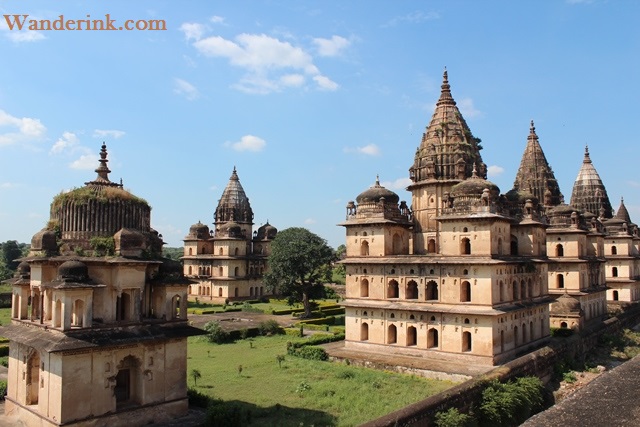
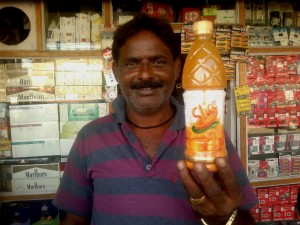
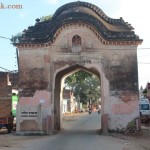
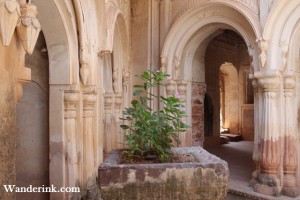
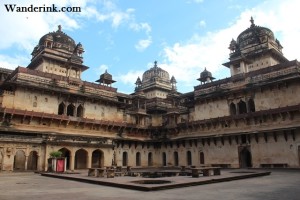
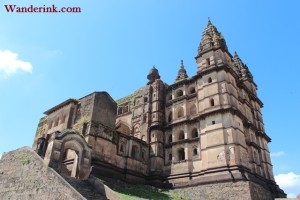
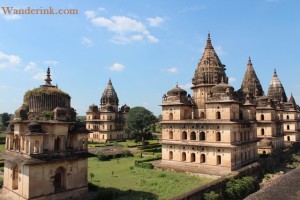
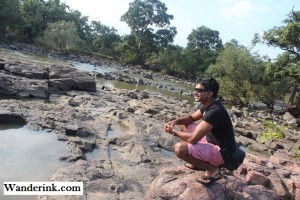










Good to know the history! Thanks for the detailed post
So virginal, so unheard of even. Not many from the domestic circuit bother to make it here.